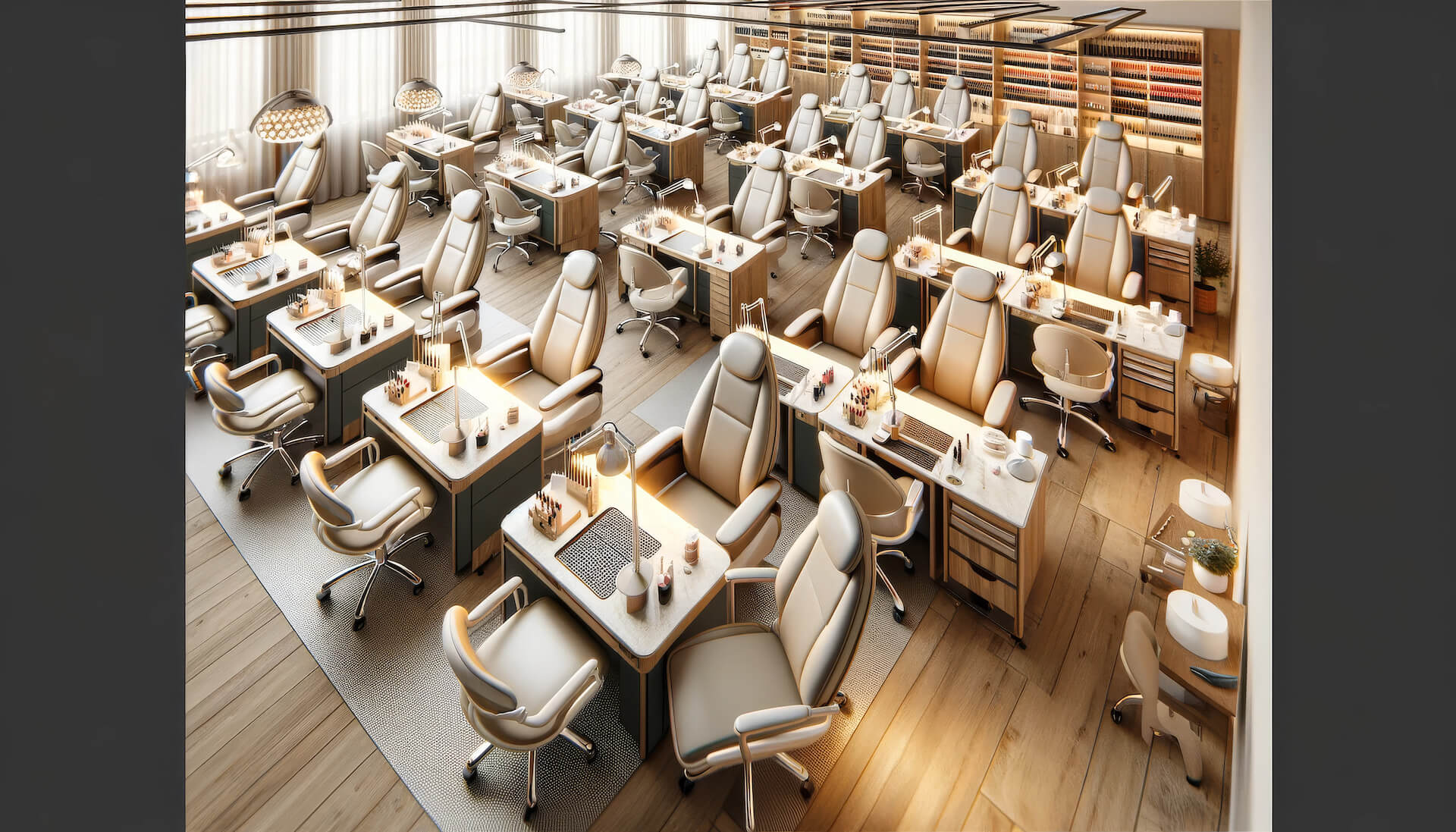The work of a manicurist requires maintaining a correct posture for long periods to prevent injuries and pains. A key element to achieve this is to have an ergonomic and comfortable manicure nail table. In this article, we will analyze the importance of choosing a manicure nail table that suits our anatomy and needs.
The Posture of the Manicurist
The ideal posture for a manicurist is sitting with a straight back, relaxed and symmetrical shoulders, knees flexed at a right angle, feet fully supported on the floor, and the head slightly inclined towards the work.
This posture reduces tension in the back and neck and prevents muscular pains. Additionally, it allows for greater precision in the work as it adopts a stable and balanced position.
Features of an Ergonomic Manicure Nail Table
To achieve a good posture, it is essential to have a manicure nail table designed ergonomically. Here are some of its characteristics:
- Adjustable Height: Allows adjusting the table to the necessary height for each manicurist, generally between 24 and 34 inches. This facilitates adopting the correct posture with elbows flexed at 90 degrees.
- Spacious Working Surface: A minimum of 20 inches wide to place all necessary instruments without overcrowding the space. This reduces the need to stretch and twist the body.
- Removable Tray: Removable tray for better access to the client. It also allows bringing the tray closer to the chest and reducing arm extension.
- Armrests: They serve a dual purpose, providing support for the manicurist’s arms and also for the client’s arms. It reduces fatigue in the shoulders and back.
- Footrest: Padded bar where the client can rest their feet. Provides greater comfort.
- Padded and Swivel Seat: Stable seat with lumbar support and the ability to rotate 360 degrees to easily access the client.
- Lightweight Materials: Tables made with lightweight materials such as aluminum or laminated wood for easy mobility.

Characteristics of an ergonomic manicure nail table
Benefits of an Ergonomic Manicure Nail Table
Working with an ergonomically adapted manicure nail table brings multiple benefits:
- Prevents muscle and back pain by maintaining a good posture.
- Reduces fatigue and tiredness even after a full day of work.
- Allows for greater productivity by being more comfortable and focused.
- Decreases the risk of injuries from repetitive movements and forced postures.
- Improves the client’s experience by being able to work more precisely and efficiently.
Types of Manicure Nail Tables According to Needs
There are different models of manicure nail tables to adapt to the needs of each professional:
Electric Tables
These are the most complete in terms of features. They allow adjusting the height electrically with just the press of a button. Some include heating on the work surface and connections for lamps and other devices.
Hydraulic Tables
They regulate the height using a pedal that activates a hydraulic mechanism. They usually have a large working surface and wheels for easy movement.
Basic Tables
Have a fixed height and simple structure, usually made of wood or metal. They are the most economical option. They serve when sharing space with other manicurists of similar stature.
Portable Tables
A flexible solution for working at home or covering peaks of demand in the salon. They are usually foldable, lightweight, and easy to transport.
Standing Tables
An alternative for working standing up. They have height adjustment and a removable tray to bring the instruments closer to the chest. Useful for short sessions or manicurists who prefer this posture.
Tips for Choosing the Ideal Manicure Nail Table
When buying a new manicure nail table, we must consider:
- Our height and physical build to choose the appropriate height and size of the working surface.
- Type of work: volume, duration of sessions, frequent clients, or different ones every day. This will define necessary functions such as electric height adjustment, heating, etc.
- Availability of space in the salon for tables of larger or smaller sizes.
- Available budget. Compare materials, features, and brands to find the best value.
- Versatility to be able to convert it into a standing table or add a stool.
- Aesthetic design in line with the salon’s decoration.
Testing the manicure nail table before buying is ideal to ensure it is comfortable. An informed
investment adapted to our needs will help us work better and healthier for years.
Frequently Asked Questions About Ergonomic Manicure Nail Tables
What are the best materials for a manicure nail table?
The most recommended materials are laminated wood, aluminum, and stainless steel. Laminated wood is lightweight, durable, and easy to clean. Aluminum and stainless steel are also durable, lightweight, and easy to maintain.
Is an electric table or hydraulic table better?
The electric one allows adjusting the height more quickly and precisely using touch controls or a pedal. The hydraulic one is more economical but requires using the lever each time the height is adjusted. Both are good ergonomic options.
How much space do I need to place the manicure nail table?
It is recommended to leave at least 2 to 2.5 meters between the manicure nail table and the wall or furniture behind. Also, provide at least 60 cm on each side of the table for mobility.
Can I use a manicure nail table as a desk?
Yes, manicure nail tables have a spacious working surface that also allows them to be used as a desk or work table for other activities with the height adjusted as needed.
Is a swivel or fixed chair better for the manicure nail table?
It is advisable to use a swivel chair to be able to easily access the client from any angle. It is also important that it has height adjustment and lumbar support.
Optimizing Posture at the Manicure Nail Table
Beyond having an ergonomic manicure nail table, it is also important to educate ourselves on how to optimize our posture to prevent injuries. Some useful tips include:
- Perform back, neck, and arm stretches before and after each workday and between clients.
- Adjust the chair height so that the elbows are flexed at 90 degrees when working.
- Alternate between standing and sitting positions to activate circulation.
- Place instruments, polishes, and other materials within reach to avoid overstretching.
- Take regular breaks every 45-60 minutes to rest your eyes and back.
- Do not hunch over, keep your back straight and shoulders relaxed at all times.
- Avoid rotating only the trunk. Instead, rotate the entire body by moving the hips and feet.
- Use footrests and armrests to reduce muscular strain on legs and arms.
Investing in the right equipment and developing good postural habits are key to a long and healthy career as a manicurist. Your body will thank you.



